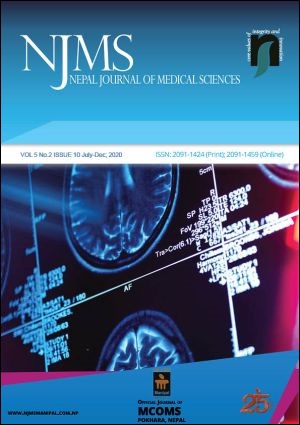Lactate Clearance as a Predictive Marker of Mortality in Adult Intensive Care Unit
DOI:
https://doi.org/10.3126/njms.v5i2.36709Keywords:
Critically Ill Patients, Diagnostic Accuracy, Lactate Clearance, Mortality, PredictiveAbstract
Introduction: Lactate clearance has been widely investigated. Serial lactate concentrations can be used to examine disease severity and predict mortality in the intensive care unit. We investigated the diagnostic accuracy of lactate concentration and lactate clearance in predicting mortality in critically ill patients during the first 24 hours in Intensive Care Unit (ICU).
Methods: It was a Prospective, observational study conducted in ICU. Sixty eight consecutive patients having blood lactate level >2 mmol/L were included irrespective of disease and postoperative status. We measured blood lactate concentration at ICU admission(H0), at six hours(H6), 12 hours(H12), and 24 hours(H24). Lactate clearance was measured for H0-H6, H0-H12 and H0-H24 time period.
Results: ICU mortality was 33.8%. Lactate clearance was 15.80 ± 17.21% in survivors and 1.73±11% in non survivors for the H0-H6 (p = 0.001) and remained higher in survivors than in non survivors over the study period of 24 hours; 17.97±15 vs. -2.04±19.84% for H0-H12 and 27.40 ± 11.41% vs. -14.83 ± 26.84% for the H0-H24 period (p < 0.001 for each studied period). There was significant difference in lactate concentration (static) between survivors and non survivors during the course of initial 24 hours. The best predictor of ICU mortality was lactate clearance for the H0-H24 period (AUC =0.89; 95% CI 0.78-1.01). Logistic regression found that H0-H24 lactate clearance was independently correlated to a survival status (p = 0.005, OR = 0.922 and 95% CI 0.871-0.976).
Conclusion: Blood lactate concentration and lactate clearance are both predictive for mortality during initial 24 hours of ICU admission.
Downloads
Downloads
Published
How to Cite
Issue
Section
License
Copyright © by Nepal Journal of Medical Sciences. The ideas and opinions expressed by authors of articles summarized, quoted, or published in full text in this Journal represents only opinions of authors and do not necessarily reflect the official policy of Nepal Journal of Medical Sciences or the institute with which the author(s) is (are) affiliated, unless so specified.




